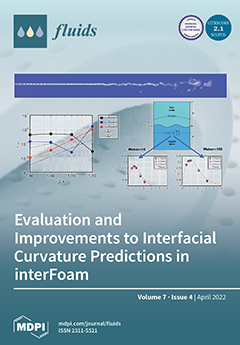Aneurysms are abnormal ballooning of a blood vessel. Previous studies have shown presence of complex flow structures in aneurysms. The objective of this study was to quantify the flow features observed in two selected saccular aneurysm geometries over a range of inflow conditions using Proper Orthogonal Decomposition (POD). For this purpose, two rigid-wall saccular aneurysm models geometries were used (i.e., the bottleneck factor of 1 and 1.6), and the inflow conditions were varied using a peak Reynolds number (
) from 50 and 270 and Womersley number (
) from 2 and 5. The velocity flow field data for the studied aneurysm geometries were acquired using Particle Image Velocimetry (PIV). The average flow field from the PIV measurement showed that the model geometry and
have more significant impact on the average flow field than the variations in
. The POD results showed that the method was able to quantify the flow field characteristics between the two model geometries. The mode shapes obtained showed different spatial structures for each inflow scenarios and models. The POD energy results showed that more than
of the fluctuating kinetic energy were captured within five POD modes for
flow scenarios, while they were captured within ten modes for
. The time varying coefficient results showed the complex interplay of POD modes at different inflow scenarios, highlighting important modes at different phases of the flow cycle. The low-order reconstruction results showed that the vortical structure either proceeded outward or stayed within the aneurysm, and this behavior was highly dependent on
,
, and model geometry that were not evident in average PIV results.
Full article





